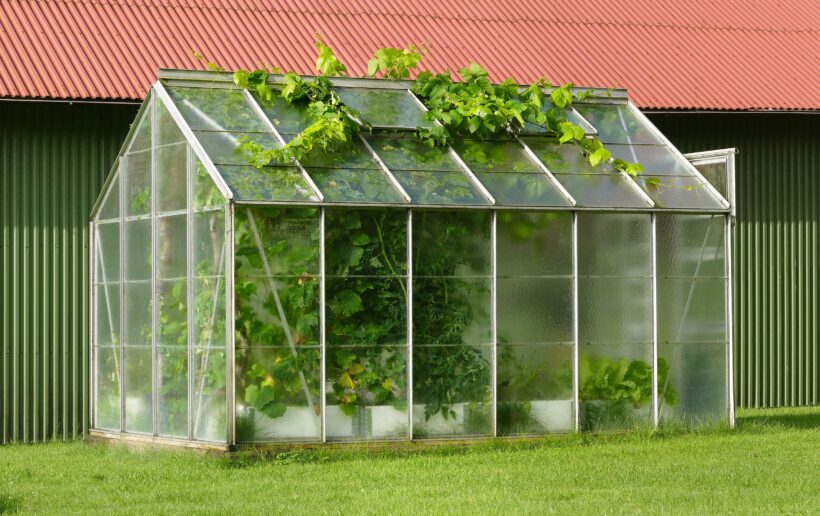
By Emma Davis
If you have a green thumb, chances are you’ve probably thought of leveling up your #plantparent chops. Sure, a potted plant here and there around your home is fun to care for and brings a pop of color to every room, but you’re ready for a new challenge.
Whether you want to grow your own food or simply love caring for your green babies, a greenhouse can be a beautiful addition to your property. But building one can be a big DIY project, and every construction choice will directly affect how well your plants thrive in their new environment. Make sure you’re building a home where your plants will flourish by including these 5 construction elements from the start.
Circulation
It’s important to keep the air temperature in your greenhouse even throughout the year so your plants don’t overheat or freeze. Since the temperature from the floor to ceiling can vary 15-20 degrees, installing an air circulation system will ensure the perfect microclimate for your plants to thrive. Keep in mind the square footage of your greenhouse when deciding the type of air-mixing fan to buy—you usually need 3-3.5 CFM per square foot.
You also need to keep in mind the quality of air in your greenhouse, since stagnant air can negatively impact your plant’s growth. Combining your air-mixing fan for circulation with an air purification system will ensure you’re bringing oxygen and carbon dioxide-rich air into your greenhouse to allow optimal photosynthesis.
Drainage
Plants love water, but too much will kill them. Having proper drainage in your greenhouse will keep your plants from being flooded and dying from drowned roots. Make sure you install both internal and external drainage systems in your greenhouse. The two most common drainage systems you can use are:
- French drains. This system uses perforated pipes which are buried in a trench and surrounded by gravel and a fabric lining. If there is too much water, it will run off your sloped floors, into the drains, and away from your greenhouse.
- Trench drains. This system uses long grates that are installed in the ground that drain the excess water into pipes and away from the plants. Trench drains are often more expensive to install than French drains but are usually more efficient at draining water.
If you live in an area that receives lots of rain, you should also build your greenhouse above the surrounding ground so the rainwater doesn’t become stagnant.
Orientation
Sunlight is of course one of the most important things your plants need to grow; building your greenhouse with the proper orientation will make it easier for your plants to get the necessary energy to thrive.
For North American greenhouse builders, the optimal orientation for your greenhouse is to facing south or southeast. This will help your plants capture that early morning sun—which will be especially important during the winter to maximize food production. You should avoid constructing a west-facing greenhouse since the strong sunlight could easily overheat your plants.
If you can’t build your greenhouse in the optimal orientation, don’t worry too much. Your optimal building position will also depend a lot on where you live. If you live in the Northwest where it’s often cloudy, your orientation will matter less since the clouds diffuse the sunlight everywhere. Your greenhouse orientation will also need to be altered depending on how high north or south you live. Research your area beforehand to see what the recommended building orientation other gardeners in your region recommend.
Foundation
If you’re building your greenhouse from the ground up, you want to make sure your foundation is solid; just because it is housing plants doesn’t mean the building doesn’t need the same structure that regular buildings need. Before you start building your greenhouse, you should check with your local housing officials or HOA to see if you need to follow specific building/zoning codes and whether you need a permit before starting your build.
The most common foundations for greenhouses are wood or concrete, but you can also use cinder blocks, bricks, or even terracotta as your foundation. If you decide on pouring a concrete slab as your floor, make sure to include areas for proper drainage. You should also keep in mind factors such as heat retention, decomposition, pricing, comfort, and traction as you decide what type of flooring to use for your flooring and foundation.
Insulation
You wouldn’t think that a glass building would need to worry about insulation, but greenhouses do. The clear walls are great for letting the sun and heat into your greenhouse, but not great at keeping the heat inside. To keep your plants warm during the colder months, insulation is crucial.
Lining your greenhouse with an inner layer of plastics (thus creating a double glaze) will help seal any air gaps and keep heat from escaping through cracks. If you’re on a budget, bubble wrap is a tried and true insulation material. With bubble wrap, the bigger the bubbles the better since it allows more light through and is a better insulator. You can buy specialized greenhouse bubble wrap that has UV stabilization, but the everyday packing materials work great in a pinch.
Insulating your plants can also provide an extra layer of warmth and protection for those cold nights. Using recycled bottles and polystyrene boxes are great insulators. You can also wrap individual pots in bubble wrap or with old newspaper to keep the roots from freezing.
Emma is a passionate environmentalist, writer, and traveler. She loves to spend time outside in the beautiful mother earth. She does her best to educate people on sustainability, travel, and lifestyle via her blogging.



Leave a Reply